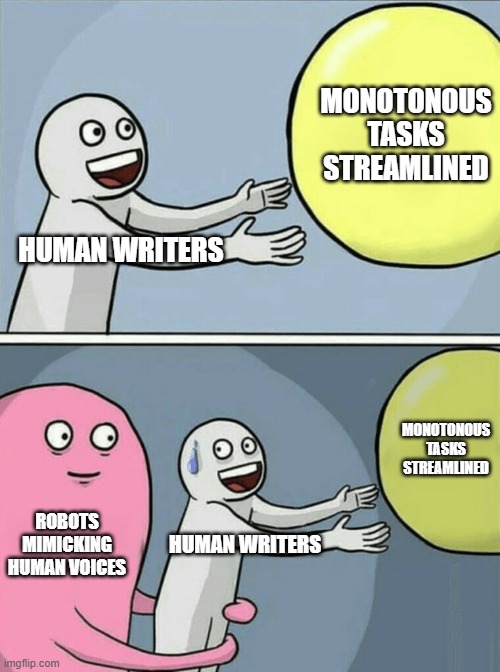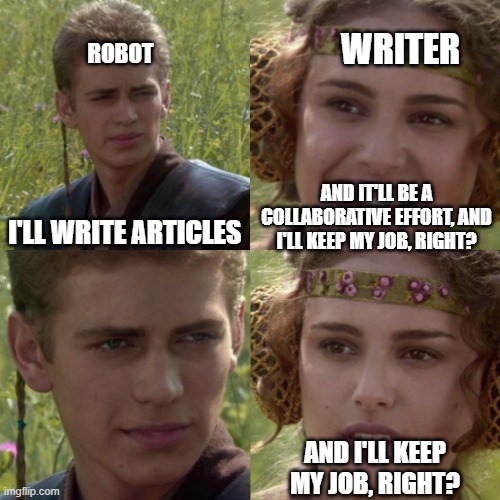I thought this career path was safe from the robots. Hey, I was convinced they'd only go after the jobs people actually want, like IT technician, pilot, or bomb disposal engineer.
But writing? C'mon. But now the robots are putting out poems like nobody's business.

The robots have been taken off the subs bench, due to the amount of content needed to create great digital experiences.
The more current, the more personalised, the more targeted the experience is, the better the customer engagement. According to Dawn Papandrea of NewsCred Insights: "Content marketing revenues are projected to grow at a 14.4% compound annual growth rate from 2017 to 2021."
Gartner estimates that “By 2020, natural-language generation and artificial intelligence will be a standard feature of 90 percent of modern BI platforms"
So, this is where Natural Language Generation, or NLG, comes in.
What is NLG?
NLG is an AI-driven software that takes a bunch of data from a bunch of sources, in order to reproduce natural sounding prose. This means taking a huge amount of raw, and meta, data and turning it into consumable text.
It can also:
- Create variations in content, determined by personas, in order to ensure the highest level of personalisation possible.
- Auto-generate text without the need for human resources, meaning team members can be deployed where they're needed most.
- Reduce time you spent creating repetitious, high quantity content, streamlining it in a fraction of the time.
“Natural language generation uses machine learning to mimic the ways human analysts learn from data and provide recommendations for action," says Kaushal Mody of Accenture.
"As such, the technology turns raw data into human narratives; communicating meaning in the same way people do, and providing complete transparency into how analytical decisions are made.”
Let's have a look into the types of NLG, why don't we?
- Basic NLG. The simplest level of NLG. Basic NLG will identify and gather a few data points, turning them into a few simple sentences. For example, a sports new site might release a report for "Leicester City vs Chelsea: 1-0"
- Template-driven NLG. This pretty much does what it says on the tin. Using template focused paragraphs, this level of NLG generates language with the help of hard-coded rules, with canned text, placeholders and special data representations.
- Advanced NLG. More flexible than the previous two categories, Advanced NLG converts data into narrative, with introductions, elaborations and conclusions. The deep learning neural network learns patterns from written language, proficiently using lexical, morphological and grammatical patterns to shape personalised and natural-sounding content. Creepy.
A subtle, but vital, part of NLG is its ability to grasp grammar. Using a combination of metadata and uh, data, it creates content that sounds human.
This is because the software uses linguistic algorithms to render the data into human-readable text, ensuring that the tone is correct, and the grammar/spelling/syntax are all top notch, with no need for human intervention.

A study conducted by Christer Clerwall reported that: “respondents were subjected to different news articles that were written either by a journalist or were software-generated. The respondents were then asked to answer questions about how they perceived the article—its overall quality, credibility, objectivity, etc.”
As we can see from the results displayed above, respondents found that the software-driven text was found to be more informative, trustworthy, and objective, while journalists’ copy was more pleasant to read. In most of the other categories of measurement, they are neck and neck. And this was four years ago; no doubt a similar study today would yield even better results for the ‘robot journalist copy’.”
It's not all robot peaches and cyber-cream, however. Though, that is a great name for a new-wave band.
As with most tech, it's important to ask:
What are the limitations of NLG?
Though it might save you time in the long run, you have to count on investing some serious man, not robot, hours into the project before it gets up and running.
Also, metadata, keywords and other data sources vital to generating the content have to be identified and structured. Without this, NLG just won't work.
Just like human writers, NLG needs time to learn a brand's specific voice. Though, it might take more time on the robots part - this is the AI/ML aspect of NLG. So, it might take some time before it figures out what makes your brand, your brand.
Plus, it can't completely replace your human writers, especially in terms of creativity. And your editors are safe as the text will still need to be tweaked and reviewed, just in case the prose isn't up to scratch.

But enough of the negatives, let's ask instead:
What are the benefits of NLG?
- Publishing. NLG allows publishers to create articles quickly, cheaply, and accurately.
- Human Resources. NLG can automate job description creation, and their publication to the job board of your choice.
- Category Pages. Seasonal updates, promotions, or buzzwords can be changed automatically, speeding up monotonous tasks using automation.
- Digital Commerce. Combining personalisation and NLG is great for digital commerce, with the AI/ML working to understand what or who a person is shopping for. This might be the difference between "Perfect for You" or "Perfect for Him".
- Images. NLG can help tag images for SEO purposes, abstracting info from pictures, and combining that info with product descriptions, and creating new text to drive better search results.
- Content Quality. Removing human error by removing the humans, I suppose. NLG makes sure all the spelling, grammar and structure are correct.
- Scaling. Your company benefits from quickly created, high quality content. This is on top of the SEO elements a robot-writer introduces automatically. With this, comes an increase in organic traffic, engagement, and dwell time.

